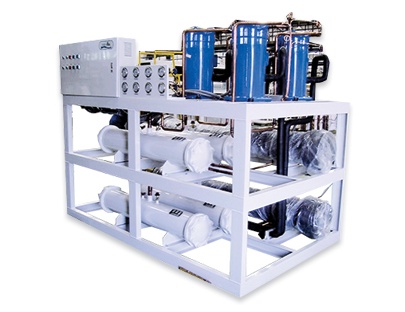Key components of the chiller:
Refrigeration compressors are essentially a pump for refrigerant gas. The capacity of the compressor, and hence the chiller cooling capacity, is measured in kilowatts input (kW), Horse power input (HP), or volumetric flow (m3/h, ft3/h). The mechanism for compressing refrigerant gas differs between compressors, and each has its own application. Common refrigeration compressors include reciprocating, scroll, screw, or centrifugal. These can be powered by electric motors, steam turbines, or gas turbines. Compressors can have an integrated motor from a specific manufacturer, or be open drive–allowing the connection to another type of mechanical connection. Compressors can also be either hermetic (welded closed) or semi-hermetic (bolted together).
In recent years, application of variable-speed drive (VSD) technology has increased efficiencies of vapor compression chillers. The first VSD was applied to centrifugal compressor chillers in the late 1970s and has become the norm as the cost of energy has increased. Now, VSDs are being applied to rotary screw and scroll-technology compressors.
Condensers can be air-cooled, liquid-cooled, or evaporative. The condenser is a heat exchanger which allows heat to migrate from the refrigerant gas to either water or air. Air cooled condenser are manufactured from copper tubes (for the refrigerant flow) and aluminium fins (for the air flow). Each condenser has a different material cost and they vary in terms of efficiency. With evaporative cooling condensers, their coefficients-of-performance (COPs) are very high; typically 4.0 or more. Air cooled condensers are installed and operated outdoors and are cooled with outside air, that is often forced through the condenser using electric fans. Water or liquid cooled condensers are cooled with water that is often in turn cooled by a cooling tower.
The expansion device (TEV) or refrigerant metering device (RMD) restricts the flow of the liquid refrigerant causing a pressure drop that vaporizes some of the refrigerant; this vaporization absorbs heat from nearby liquid refrigerant. The RMD is located immediately prior to the evaporator so that the cold gas in the evaporator can absorb heat from the water in the evaporator. There is a sensor for the RMD on the evaporator outlet side which allows the RMD to regulate the refrigerant flow based on the chiller design requirement.
Evaporators can be plate type or shell and tube type. The evaporator is a heat exchanger which allows the heat energy to migrate from the water stream into the refrigerant gas. During the state change of the remaining liquid to gas, the refrigerant can absorb large amounts of heat without changing temperature.
